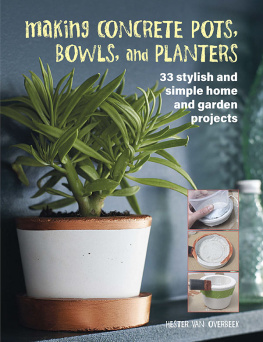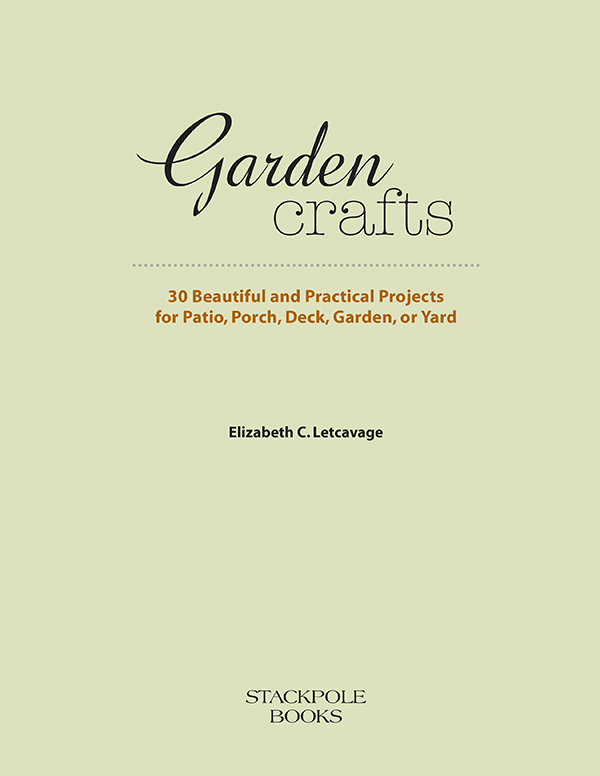Copyright 2015 by Stackpole Books
Published by
STACKPOLE BOOKS
5067 Ritter Road
Mechanicsburg, PA 17055
www.stackpolebooks.com
All rights reserved, including the right to reproduce this book or portions thereof in any form or by any means, electronic or mechanical, including photocopying, recording, or by any information storage and retrieval system, without permission in writing from the publisher. All inquiries should be addressed to Stackpole Books, 5067 Ritter Road, Mechanicsburg, Pennsylvania 17055.
Printed in the United States of America
10 9 8 7 6 5 4 3 2 1
First edition
Cover design by Tessa J. Sweigert
Cover image by Alan Wycheck
Photos by Alan Wycheck except where noted
Library of Congress Cataloging-in-Publication Data
Letcavage, Elizabeth.
Garden crafts : 30 beautiful and practical projects for patio, porch, deck, garden, or yard / Elizabeth C. Letcavage. First edition.
pages cm
Includes index.
ISBN 978-0-8117-1303-0
1. Garden ornaments and furniture. 2. Handicraft. I. Title.
SB473.5.L47 2015
745.5dc23
2014040647
eBook ISBN 978-0-8117-6173-4
Introduction
G ardening and crafting are high on my list of passions in life, and I suspect there are many like-minded people who share these two hobbies. We all nd pleasure in transforming a pile of stuff into something beautiful and often useful. Many of the projects in this book offer opportunities to recycle, repurpose, and reuse items that would otherwise go to the landll. And gardeners will appreciate that deer, rabbits, groundhogs, and other critters will not eat them!
These craft projects require a wide range of materials. While I list particular brands that worked well, there are a host of suitable substitutes. Every crafter has favorite brands of materials and tools, so use what you are accustomed to and have on hand.
Design and color use are also matters of personal preference. There are innite ways to express yourself with these garden projects. I hope that you will be inspired to make each project your own.
Like ephemeral spring owers, all craft projects will fade and deteriorate over time if exposed to the elements. They may not be family heirlooms, but I hope you will enjoy your handcrafted artwork and your garden for many seasons to come.
Happy crafting!


Safety Gear
The most important equipment you will need before starting any project is protective gear. Safety glasses are a must anytime you work with hammers, saws, drills, sanders, and dusty materials. Gloves are often a personal choice; however, the occasions where they are highly recommended are noted in the instructions. A dust mask is only called for when projects involve concrete, mortar, or grout, but you may also want to wear one when sanding. Please stay safe and use your gear.
Vise
Often materials need to be held down for cutting or assembling. If you don't own a workbench vise, consider investing in a lightweight, portable work station, which can be moved to your preferred work site, indoors or out. Top with a piece of plywood and you have a small workbench.
Measuring and Marking Tools
The old carpenters saying, Measure twice, cut once, is good advice for crafters, too. A metal yardstick and 10' metal tape measure are good investments. A exible seamstress tape is required to measure curved or round objects. A carpenters triangle is handy, but not necessary. You'll also need a handful of sharpened pencils and a fine-tipped permanent marker. Even though the projects in this book provide marking and cutting measurements, you will want to calculate them using your project materials.
Adhesives
The many great adhesives on the market today serve every purpose imaginable. The project instructions will specify which glues to use, but you may be able to substitute in many cases. Check the products packaging for a list of materials the glue will adhere. For these outdoor projects, heavy duty construction adhesive, applied with an inexpensive caulking gun, is a go-to product. Another product you'll want to have on hand is clear silicone tub and tile sealant, which is sold in a resealable tube. White glues (PVA type) and yellow (wood) glues are used routinely. Select those that are water resistant or waterproof. Specialty glues, such as CPVA, fabric, super-type and permanent rubber-based epoxy, are also used in some of the projects.
Surface Protectors
Stock up on tarps, drop cloths, old towels, and plastic sheeting. Almost every craft project in the book requires tabletop or workbench protection.
Tools
Roy Underhill is still working at The Woodwrights Shop on PBS television making wonderful furniture the oldfashioned way with just hand tools. He proves its possible, but for the modern crafter power tools offer a fast and accurate way to get things done. Heres a rundown of the tools used to make these garden crafts.
The one essential tool is a battery-powered hand drill. (Opt for a combination drill/screwdriver if you are buying a new one.) You'll also need a set of the common size drill bits. A couple of projects require large drill bits and a spade (or butterfly) bit to make large holes. Borrowing these items may be a good option if you are only going to use them occasionally.
A well-stocked crafters tool bag will always include sharp scissors, a utility knife, and wire cutters. A hacksaw is used to cut metal pipe and rod, and a wood handsaw takes care of small jobs.
Hammers and wrenches are staples in the household tool box, but you may not have chisels and clamps. These items are not used extensively, so you may choose to borrow these, as well. A tack hammer (a small version of a hammer) is used quite a bit for fastening more delicate pieces.
A power hand sander is helpful, but if you dont have one, thats not a problem. Most of the projects are rustic and need only a light sanding to remove splinters and old paint. A small 2" x 4" scrap of wood can serve as a sanding block. (A rotary tool is recommended for making the watermelon slice punk holder; although hand sanding is possible, it will take some effort.)
Fasteners
The fastener used most often for outdoor projects in this book is a galvanized deck screw. Theyre strong and dont rust. Have plenty of these on hand. Finish nails and regular staples are also used in abundance. You may not be familiar with the U-shaped wire staples, but chances are you will find many other uses for them in your future crafting projects. Sizing for eye bolts and screws and S-hooks is specified with each project and these may be purchased individually or in bulk packs at hardware stores.
Hangers
Before you buy wire to hang or connect something, check around the house. Those who ardently repurpose things will have an adequate supply of wire on hand. Computer cables and old telephone cords will fill the bill in many cases. Chain is a bit pricey when sold by the foot, so check discount stores for prepackaged jack chain to save money. Heavy-weight monofilament can be used for more than just catching fish. It is strong and clear, so it does not compete for attention with the finished project.














